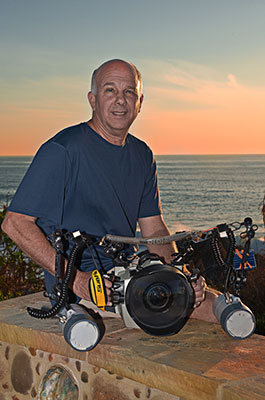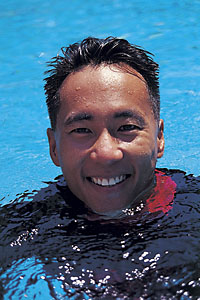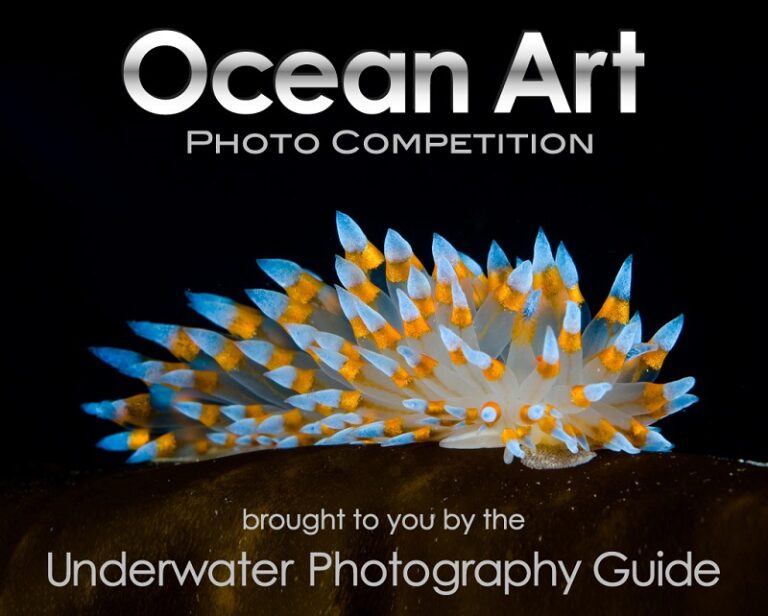
The Ocean Art Underwater Photo Competition is one of the most prestigious underwater photo contests in the world, attracting some of the world’s most talented photographers. This year 13 different categories ensured a fun competition for all camera classes and disciplines of underwater photography.
If you haven’t yet, be sure to check out the 2021 Ocean Art Contest Winners.
Ocean Art would not be possible without our esteemed judging panel, who has decades of experience and some of the most prestigious awards in the diving, photo, and video industries.
Here is what our judges had to say about this year’s competition.
Marty Snyderman

The author of Dive Training magazine’s Behind the Lens column, Marty Snyderman has made his living as an underwater photographer, photography instructor, author, and speaker for close to 40 years. He has won many prestigious awards (including an Emmy) and has been featured in many top publications worldwide.
As has been the case in previous years, I thoroughly enjoyed participating as one of the judges in the 2021 Ocean Art photography contest. Once again, we saw a number of wonderful images and I would like to congratulate all of the photographers whose photographs were recognized in the various categories.
While Tony, Mark, and I generally agreed on the images that should be recognized as winners and with honorable mentions, we did have some different opinions. Our differences always serve to remind me that judging photography contests is subjective. So, while we hope the photographers whose images received recognition feel a sense of accomplishment, we realize that other judges might have recognized some photographs that we did not.
As judges, we were asked to offer some suggestions/tips about images entered in photography contests. Here is my two cents: Read the rules. A surprising number of photographers enter images that violate the rules for the contest or the various categories. Judges are quick to disqualify those photographs no matter how good they are.
Be careful about over processing images. Manipulating photographs with post-capture software is a skill that takes some effort and time to master to any degree. The biggest flaw is usually being too heavy handed, especially over saturating and over sharpening images. In many instances the subject was originally under lit with a strobe and the colors lacked impact. The photographer “fixes” the subject or part of the subject, but in doing that causes other elements in the frame to appear unnatural- grossly oversaturated. Similarly, being heavy handed when sharpening a photograph quickly makes a negative impression with judges.
I would also suggest that the same photographer not enter two or more similar images in the same category. The photographs compete against each other and it is less likely that any of the images will gain recognition.
I am going to end my comments by encouraging everyone to go diving, make some great photographs, share them with the rest of us, and enter your better ones in the 2022 Ocean Art contest. I look forward to seeing those photographs later this year!
Mark Strickland
Mark Strickland has done over 10,000 dives and had careers as lifeguard, boat captain, scuba instructor and cruise director. He’s been passionate about underwater photography all his adult life and leads several photo expeditions each year for Bluewater. Mark’s work has appeared in many publications around the world, and has been displayed at the Smithsonian Institution and United Nations Visitor Center as well as several renowned galleries.
https://www.markstrickland.com/
Thank you to all who took part in this year’s competition. Just by participating, you are helping to increase the public’s appreciation of the beauty and vulnerability of the underwater environment. Competitions like Ocean Art also serve as great inspiration to your fellow underwater photographers, including us judges!
Once again, it was an honor to work with such highly accomplished judges as Tony and Marty, each of whom are luminaries in the realm of underwater imaging, and contribute a wealth of knowledge, insights and artistic sensibilities to the process. Just like last year, I was excited to be involved, and hope to have lived up to the expectations surrounding this prestigious competition.
Despite the drastic decline in dive travel compared to previous years, I was impressed by the number of quality images in most categories, including those taken with compact cameras. Of course there are still advantages to high-end mirrorless and DSLR systems, but having separate categories for compacts goes a long way toward leveling the playing field. This leads to more participation, and also tends to de-emphasize the importance of certain technical specifications, encouraging all underwater shooters to concentrate more on the artistic side of underwater photography.
Because of the huge number of noteworthy images, I found it very difficult to limit my selections to the relative few that would go on to the next round of judging. Photos with obvious technical problems were easy to eliminate, but we soon reached a point where every remaining image had widespread appeal. Even in Round 1, I found myself despairing over having to eliminate images that were only slightly less impressive than those advancing to the next round. Soon, it was no longer a question of whether an image was aesthetically pleasing and technically correct; progress now depended on even harder but necessary decisions, eliminating yet more images that were merely excellent, in favor of those truly outstanding ones that would become finalists.
Although we judges have decades of u/w photo experience and have much in common in terms of appreciation for quality underwater imaging, the art of photography is still very subjective, so naturally we found ourselves disagreeing on certain images. Such debates add to the time and effort required to complete the judging, but are an essential part of the process, allowing each judge to consider different points of view and aesthetic sensibilities. Thanks to these interactions, I think we all gained perspective that made for a truly collaborative process, resulting in a selection of winners that we are all proud to have chosen.
For anyone considering future competitions, a few suggestions come to mind. Read the rules thoroughly. Think carefully about the most appropriate category for each image. Just because a photo was taken with a wide lens doesn’t mean it must go in the wide-angle category, especially if it depicts great behavior or a strong environmental message. Resist the urge to over-process; we saw many otherwise great photos ruined by such heavy-handedness, especially with vibrance, dehaze and sharpening. If possible, calibrate your display before adjusting images, so that they look the same on the judges’ screens as they do on yours. Take advantage of allowable editing such as minor cropping and tonal adjustment, as there were many potentially great images that could not be chosen because these simple edits had been omitted. And, while it’s fine to admire the work of others and emulate certain techniques and approaches, strive to create something new and different, rather than just copying someone else’s successful efforts.
To those whose images were honored this year, congratulations! Not only will you be taking home some great prizes, but perhaps more significantly, you can take great pride in having your work chosen out of an extremely competitive field that includes some of the world’s most accomplished underwater shooters.
If your images were not chosen, don’t be discouraged. Considering how many excellent images are entered and the highly subjective nature of judging, it’s normal that many great, potentially prize-winning images are bypassed. It happens with every major contest, and is just the nature of such events. So, if you have images that you’re proud of and feel are well suited for other contests, I encourage you to enter them. And whether you’re out to win or simply enjoy sharing images with friends and family, remember that satisfaction comes not only from capturing great images, but also the broader experience of being an underwater photographer. So embrace the entire process, from researching future dive locales to familiarizing yourself with potential subjects and behaviors, to fine-tuning your equipment and techniques. Seek out a new destination or revisit an old favorite, take time to chat with local people, and enjoy the whole experience. When you encounter difficulties, whether it involves dive conditions or equipment, remember that this, too, is part of the experience, and will help you grow as a photographer.
Wishing everyone a happy, healthy and rewarding 2022, hopefully including lots of time underwater!
Tony Wu
Author of a coffee table book entitled Silent Symphony, which received the grand prize for best book of the year at Antibes in 2001. He has also won both the Underwater and Mammal Behaviour categories of the Wildlife Photographer of the Year competition
Happy new year, and congratulations to all the photographers behind all the selected images.
It was particularly nice to see a wide selection of submissions, given the difficult times that we are in. Mark, Marty and I had an enjoyable time discussing our views, even when we disagreed (i.e., when Marty was wrong).
This brings up an important point. Please keep in mind that contests are subjective. The winning images of course must meet basic photographic criteria, but there is also an element of preference involved. What one person finds appealing, another may find less so. Which is to say, please do not be overly discouraged if your submission was not chosen.
Within this context, there are a few observations/ hints that I think are worth communicating, in case anyone actually reads this.
First, contests have rules. The rules may vary somewhat from contest to contest, but in all cases, submissions that don’t comply with stated rules cannot win. As a simple example, among other things, the rules for this contest state that one cannot remove “divers, fish, bubbles, ropes” and such. It is disappointing for all concerned to have images we select later disqualified because things were removed.
Second, if you’re thinking of submitting to the black and white category, please familiarize yourself with concepts like tonal range and contrast, which are fundamental to creating black and white images. Grayscaling a color image doesn’t make it a good black and white image. It makes is a grayscaled color image. There is a world of difference. Over the years, there have been many images that I really wanted to like, but it was clear that there wasn’t enough thought given to the process/ conversion from color to black and white. It is a shame when that happens, because often all it takes is a few minor adjustments to turn an image from one that will not be selected into a potential winner.
Third, please don’t abuse your file. Every camera available today can capture lots of information and produce beautiful files, especially with the judicious application of photo editing software—judicious being the important word. It is often tempting to add just a little bit more saturation and/ or vibrance, then a wee bit more, and then just a finishing touch. And then a pinch for good measure. One thing you want to avoid though is going too far, ending up with a photo that has unrealistic colors. Before submitting to any contest, maybe step away for a couple of days and take another look at your photo with a fresh pair of eyes.
Finally, creativity and originality count for a lot. It has been a fascinating process to see over time fads come and go—places that are “in” for a while; subjects that are “the thing” for a period of time; techniques/ equipment that become all the rage for some time, etc. From the perspective of judging a photo contest—the first time we see something, it can be very interesting. Thereafter, novelty value drops, and in certain instances, the appeal disappears entirely or even becomes annoying. What I’m saying is that it’s good to experiment, to see if you can photograph something that everyone else seems to have photographed, but in a different way. Or alternatively, to photograph something that other people ignore, and make it beautiful/ dramatic/ sensational. I know this is much easier said than done, but that’s why having a photo recognized in a contest is difficult, and something to be proud of when it happens.
Best of luck for lots of quality submerged time in 2022!
Back to the Ocean Art 2021 Winners page
















